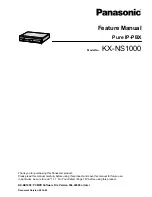
1.1 System Highlights
Installation Manual
21
–
High Sound Quality
Calls between KX-NT300 series IP-PTs support G.722 CODEC allowing for high sound quality
conversations.
SIP (Session Initiation Protocol) Extensions
This PBX supports the connection of third party SIP supported IP telephones (hardphones and
softphones). SIP Extensions make and receive calls using IP.
IP Softphones
This PBX supports the connection of Panasonic IP softphones, providing IP-PT operations and features
using software on a PC.
Internet Protocol (IP) Related Features
Server Connection
This PBX supports the connection to the following servers, allowing for enhanced efficiency and record
keeping:
–
SNMP Server:
Allows for users assigned as SNMP managers to manage and receive PBX system status
information, such as local alarm information and general system activity using Simple Network
Management Protocol (SNMP).
–
SNTP Server:
Allows for the PBX to automatically receive and update the time setting using Simple Network Time
Protocol (SNTP).
–
DHCP Server:
Allows for this PBX to receive IP addresses from a Dynamic Host Configuration Protocol (DHCP)
server.
Peer-to-peer Connection
Intercom calls can be made between peer-to-peer compatible IP extensions allowing for
communication without using the PBX's VoIP resources.
Networking Features
This PBX supports the following private networking features:
Voice over Internet Protocol (VoIP) Network
This PBX can be used on a private network which implements VoIP. On this type of network, information
is sent over the private network in IP packets, which allows voice as well as data to be sent to other
devices in the private network. Automatic rerouting of VoIP calls to public CO lines is also available in
case of network difficulties.
TIE Line Service
PBXs can be connected via a privately leased telephone lines, forming a private network. These "TIE
lines" provide a cost-effective way to route calls and communications, and are often used to connect
corporate offices located in different cities.
QSIG Support
TIE line service can be used on a private network that is established using Voice over Internet Protocol
(VoIP) with the IP-GW card, or ISDN (PRI) lines programmed to implement the QSIG protocol (Q.931).
QSIG offers TIE line service as well as advanced caller and called party identification features.
Summary of Contents for KX-TDE110
Page 38: ...1 4 Specifications 38 Installation Manual ...
Page 44: ...2 1 Information about the Activation Keys 44 Installation Manual ...
Page 166: ...3 14 Starting the PBX 166 Installation Manual ...
Page 186: ...5 1 Troubleshooting 186 Installation Manual ...
Page 187: ...Installation Manual 187 Index ...
Page 191: ...Index Installation Manual 191 ...





































